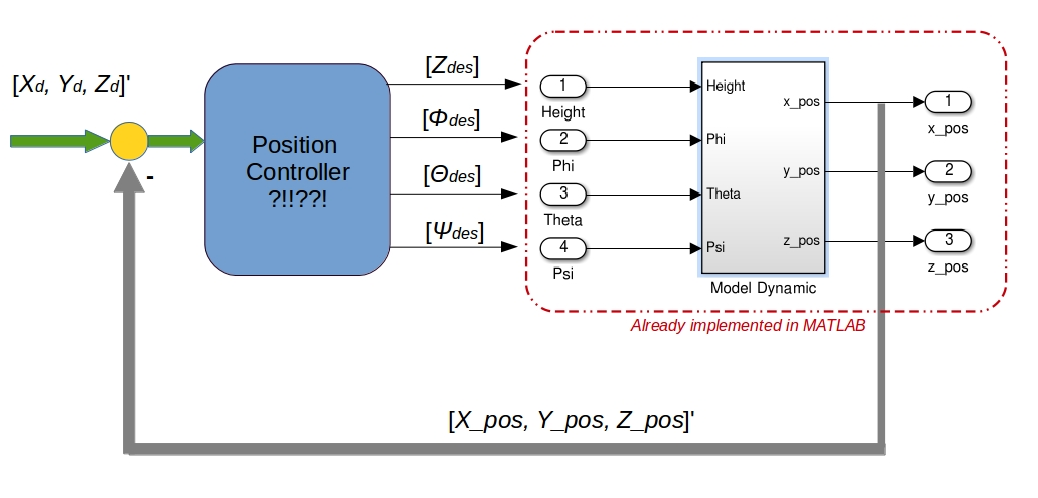I have a question regarding the implementation of a quadrotor's position controller. In my Matlab model the quadrotor takes 4 inputs: a desired altitude ($Z_{des}$) and desired attitude angles($\Phi_{des}$, $\Theta_{des}$, $\Psi_{des}$) which reflects the motion described by the differential equations of the model (see last picture).
Here an insight into the implemented Matlab dynamic model. As you can see it has a structure like an inner loop controler:
Anyway...it "hovers" perfectly on the starting point. (perfect graphs :) ) Now I just need to go over and implement a sort of position controller to let the quadrotor to get from a start to a goal point, defined as usual through 3 coordinates $[X_d, Y_d, Z_d]$.
That's tricky because I don't have the same space state variables as input and output of the system. So the controller must take a vector of three coordinates and be able to output 3 different angles to get there. The only exception is the height because it will be simply bypassed by the controller and doesn't need another calculation loop. A different story is for the three angles...
My first idea was to simply create a feedback between the position given at the output of the simulated system and the desired position as in the figure above. But that rises another question: my quadrotor model solves the following equation system:
$$ \large \cases{ \ddot X = ( \sin{\psi} \sin{\phi} + \cos{\psi} \sin{\theta} \cos{\phi}) \frac{U_1}{m} \cr \ddot Y = (-\cos{\psi} \sin{\phi} + \sin{\psi} \sin{\theta} \cos{\phi}) \frac{U_1}{m} \cr \ddot Z = (-g + (\cos{\theta} \cos{\phi}) \frac{U_1}{m} \cr \dot p = \frac{I_{YY} - I_{ZZ}}{I_{XX}}qr - \frac{J_{TP}}{I_{XX}} q \Omega + \frac{U_2}{I_{XX}} \cr \dot q = \frac{I_{ZZ} - I_{XX}}{I_{YY}}pr - \frac{J_{TP}}{I_{YY}} p \Omega + \frac{U_3}{I_{YY}} \cr \dot r = \frac{I_{XX} - I_{YY}}{I_{ZZ}}pq - \frac{U_4}{I_{ZZ}} } $$
that means that they expect (as in the matlab model above) the desired angles and height. But now I need right the inverse: given a desired position calculate the right angles!!! For the direction is the solution really simple, since I can write something like:
Psi = atan2( (yd - yactual), (xd - xactual) );
where y and x lies on the horizontal plane. This is not so simple for the other two angles. So what can I do at this point? Just "invert" the given equations to get the desired angles?
Another idea could be to implement a simple PD or PID controller. This is much more easier given the fact that I can experiment very quickly using Simulink and get very good results. But the problem is here again: how get I the desired angles from a desired position?

